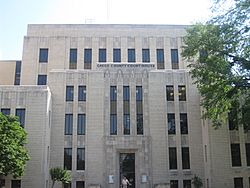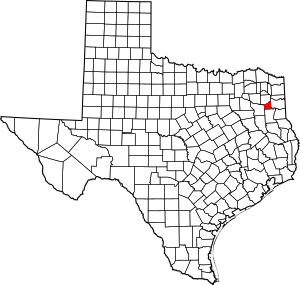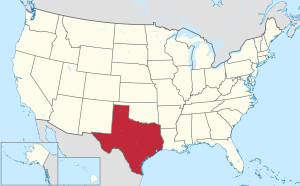Gregg County, Texas facts for kids
Quick facts for kids
Gregg County
|
||
|---|---|---|

The Gregg County Courthouse of Art Deco design in Longview designed by architects Voelcker and Dixon. William R. Hughes was the county judge when the structure was completed in 1932.
|
||
|
||

Location within the U.S. state of Texas
|
||
 Texas's location within the U.S. |
||
| Country | ||
| State | ||
| Founded | 1873 | |
| Named for | Gen. John Gregg | |
| Seat | Longview | |
| Largest city | Longview | |
| Area | ||
| • Total | 276 sq mi (710 km2) | |
| • Land | 273 sq mi (710 km2) | |
| • Water | 2.5 sq mi (6 km2) 0.9% | |
| Population
(2020)
|
||
| • Total | 124,239 | |
| • Density | 450.1/sq mi (173.80/km2) | |
| Time zone | UTC−6 (Central) | |
| • Summer (DST) | UTC−5 (CDT) | |
| Congressional district | 1st | |
Gregg County is a special area called a county in the eastern part of Texas. Think of it like a district within a state. In 2020, about 124,239 people lived there.
The main city and center of the county's government is Longview. This is called the county seat. Gregg County is named after John Gregg, who was a general during the American Civil War.
Gregg County is part of the larger Longview, Texas metropolitan area. It's also part of a bigger area that includes Longview and Marshall. In October 1930, oil was found near Kilgore. This started an "oil boom" that brought many workers to the county. The population grew by more than 500% by 1940! The East Texas Oil Field is still very important to the county's economy today.
Contents
History of Gregg County
This area was settled by people from the United States even before Texas became its own country. Later, Texas joined the United States. Early on, the land was used for large cotton farms called plantations. These farms relied on the forced labor of enslaved African Americans. People also cut down trees from the pine forests to clear land and for wood.
Gregg County was officially created in 1873, after the American Civil War. It was made from parts of Harrison, Rusk, and Upshur Counties. A representative named B. W. Brown suggested creating a new county. He likely wanted to change the politics in Harrison County, where many Black citizens had power.
The new county was first going to be called Roanoke. Longview was chosen as its county seat. Later, the name was changed to honor General John Gregg. The people of the county then voted to decide where the county seat would be.
Harrison and Rusk Counties didn't want to give up their land to Gregg County. So, when Gregg County was first formed, it only got about 143 square miles from Upshur County. The Sabine River became its southern border. In April 1874, about 141 square miles south of the Sabine River were added from Rusk County. However, a planned part from Harrison County, about 145 square miles, was never added.
By 1919, Gregg County had about 16,700 people. Almost half of them (48%) were Black. Most Black residents worked as sharecroppers or tenant farmers, growing cotton. The Negro Business League started a cooperative store in Longview. This store helped Black residents have more choices for shopping.
In July 1919, there was a short period of conflict in Longview. One Black man was killed, and some Black-owned homes were burned. The local sheriff asked for help from the Texas National Guard and other police. They set a curfew and took control to stop the fighting.
During the Great Depression in the 1930s, farming jobs became scarce. Many African Americans moved north to find work. This movement was called the Great Migration.
In October 1930, a huge oil discovery happened near Joinerville. Soon after, more oil was found in Gregg County near Pine Tree/East Mountain. This made the county's economy boom! So many workers came that the population grew by over 500% by 1940. The growth slowed down, but oil is still very important to the area. Today, about 20% of the population is African American.
Geography
Gregg County covers a total area of 276 square miles. About 2.5 square miles (0.9%) of this area is covered by water.
Main Roads
Neighboring Counties
- Upshur County (north)
- Harrison County (east)
- Rusk County (south)
- Smith County (west)
Towns and Cities
Cities
- Clarksville City (a small part is in Upshur County)
- East Mountain (mostly in Upshur County)
- Easton (partly in Rusk County)
- Gladewater (partly in Upshur County)
- Kilgore (a small part is in Rusk County)
- Lakeport
- Longview (a small part is in Harrison County)
- Warren City (a small part is in Upshur County)
- White Oak
Special Communities (Census-designated places)
Other Small Communities
- Danville
- Elderville
- Fredonia
- Gladewater Park
- Judson
- Kinsloe
- Seven Pines
- Shiloh
- Teneryville
Past Communities
- Greggton - became part of Longview in the 1950s.
- Spring Hill - became part of Longview on October 7, 1983.
Population Information
| Historical population | |||
|---|---|---|---|
| Census | Pop. | %± | |
| 1880 | 8,530 | — | |
| 1890 | 9,402 | 10.2% | |
| 1900 | 12,343 | 31.3% | |
| 1910 | 14,140 | 14.6% | |
| 1920 | 16,767 | 18.6% | |
| 1930 | 15,778 | −5.9% | |
| 1940 | 58,027 | 267.8% | |
| 1950 | 61,258 | 5.6% | |
| 1960 | 69,436 | 13.4% | |
| 1970 | 75,929 | 9.4% | |
| 1980 | 99,487 | 31.0% | |
| 1990 | 104,948 | 5.5% | |
| 2000 | 111,379 | 6.1% | |
| 2010 | 121,730 | 9.3% | |
| 2020 | 124,239 | 2.1% | |
| U.S. Decennial Census 1850–2010 2010 2020 |
|||
In 2000, there were 111,379 people living in Gregg County. By 2020, the population had grown to 124,239 people. This shows that the county has been growing, just like many other parts of Texas.
The table below shows the different racial and ethnic groups in Gregg County over time.
| Race / Ethnicity (NH = Non-Hispanic) | Pop 2000 | Pop 2010 | Pop 2020 | % 2000 | % 2010 | % 2020 |
|---|---|---|---|---|---|---|
| White alone (NH) | 76,851 | 74,005 | 68,050 | 69.00% | 60.79% | 54.77% |
| Black or African American alone (NH) | 21,989 | 24,068 | 24,974 | 19.74% | 19.77% | 20.10% |
| Native American or Alaska Native alone (NH) | 426 | 497 | 424 | 0.38% | 0.41% | 0.34% |
| Asian alone (NH) | 745 | 1,316 | 1,614 | 0.67% | 1.08% | 1.30% |
| Pacific Islander alone (NH) | 17 | 35 | 47 | 0.02% | 0.03% | 0.04% |
| Other race alone (NH) | 46 | 119 | 298 | 0.04% | 0.10% | 0.24% |
| Mixed race or Multiracial (NH) | 1,122 | 1,672 | 4,792 | 1.01% | 1.37% | 3.86% |
| Hispanic or Latino (any race) | 10,183 | 20,018 | 24,040 | 9.14% | 16.44% | 19.35% |
| Total | 111,379 | 121,730 | 124,239 | 100.00% | 100.00% | 100.00% |
In 2000, the average income for a family in the county was about $42,617 per year. By 2020, the average household income had increased to $52,027. This shows that the economy in Gregg County has improved over time.
Education
Several school districts serve the students in Gregg County:
- Gladewater ISD (also in Smith and Upshur Counties)
- Kilgore ISD (also in Rusk County)
- Longview ISD
- Pine Tree ISD
- Sabine ISD
- Spring Hill ISD
- White Oak ISD
All these school districts are part of the Kilgore Junior College zone. This means students from these areas can attend Kilgore Junior College.
Local Media
Gregg County is part of a media market that includes Tyler, Longview, and Jacksonville. Local TV stations include KLTV, KTRE-TV, KYTX-TV, KFXK-TV, KCEB-TV, and KETK-TV.
The main newspaper in the county is the Longview News-Journal, published in Longview. You can also find news about the area in the Tyler Morning Telegraph, which is based in Tyler. The Gladewater Mirror has been published since 1949, first daily and now weekly.
Gallery
See also
 In Spanish: Condado de Gregg para niños
In Spanish: Condado de Gregg para niños





